The Best Powered Mixer for Consoles & Box/Racks
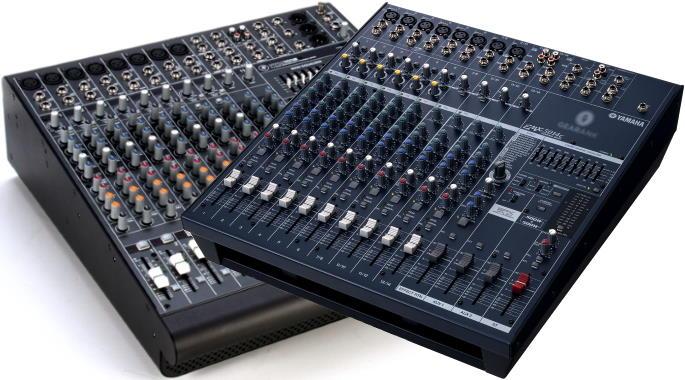
Author & Contributors
Raphael Pulgar
I've been an audio engineer for 20 years specializing in rock and metal recordings. I also play guitar and produce original music for my band and other content creators.
The Best Powered Mixers Under $500
Rockville RPM45
Cons
- Cooling fan can get loud
Pros
- High headroom for the size
- 4 Channels with independent EQ and reverb
- High-quality enclosure
The RPM45 is a powered mixer with a lot of clean headroom in a high-quality wooden enclosure.
It features 4 channels with independent bass and treble controls with independent Reverb.
A power rating of 225w x 2 @ 8 Ohms pushes passive speakers with plenty of clean headroom.
Clean gain is important, and the RPM45 has plenty. Even at 90% output, it gets loud enough for small to medium venues.
However, with great power comes great heat production. The cooling fan gets loud, but that should only matter in quiet studio recordings.
The Rockville RPM45 is the best audio mixer option for those with limited budgets. It's a readily available, loud, and clean-powered PA head that is sure to liven up your small gatherings.
Specifications
- Inputs: 4 x 1/4” TRS inputs, 1 RCA L/R AUX input, 1 1/4” Effect loop input/output
- Channels: 4
- Power Rating: 225w x 2 @ 8 Ohm (Parallel mono) (RMS)
- Phantom power: 4 Channels
- Equalizer: Treble, Bass (per channel)
- Outputs: 8-ohm dual 1/4” speaker outputs, 1 RCA L/R Rec output
- Onboard FX: Echo and Delay
- Weight: 18Lbs.
Behringer Europower PMP1680S
Cons
- Might not be enough for large venues
- No input attenuation
Pros
- Powerful Class D amplification
- Quiet operation
- Dual graphic EQ and Multi FX
- Good amount of jack inputs
The Europower PMP1680S features a loud Class D amplifier with 2 x 300W RMS (1,600W bridged) at 8 ohms. It is part of the popular Behringer Euro Mixer line, which is considered one of the best digital mixers in the entry-level price range.
Even with the power rating, the Class D amplifier itself runs cool and foregoes the need for large heat sinks or loud fans. And it does a good job of keeping your audio signal clear and clean.
The PMP1680S also features dual graphic EQs for overall sound sculpting as well as dual multi-fx processors that feature reverb, delay, modulation, and more.
Multiple XLR inputs enable multiple singers or band members to output to FOH. This makes the PMP1680S a good mixer for those who are looking to start a band.
The amount of clean headroom is capable of driving speakers to fill small and medium size venues easily.
For larger venues, however, the power might fall short. Another thing lacking is input attenuation. But it is more than enough to handle the main mix duties in small venues.
The Behringer Europower PMP1680S is a versatile powered mixer with a versatile dual EQ and dual Multi-FX section. If you're looking for a standalone powered mixer for small to medium size venue audio production, this is a great pick. It is also ideal for typical gigs and rehearsals, especially if you need onboard effects like reverb and delay.
Specifications
- Inputs: 8 x XLR, 4 x TRS, 2 x RCA, 2 x 1/4"
- Channels: 10
- Power Rating: 2 x 300W RMS @ 8 ohms
- Phantom power: 8 x Channels
- Equalizer: dual 7-Band Graphic EQ
- Outputs: 2 x speakON, 2 x RCA, 1 x 1/4" (Monitor), 2 x 1/4" (Send), 2 x Post (FX), 1 x Pre (Monitor)
- Onboard FX: reverbs, echo, chorus, delays, multi-fx
- Weight: 21.8 lbs. lbs.
| Website | Source | *Rating Value |
| YouTube | JUST ONE ID10T | 90/100 |
The Best Audio Mixers Over $500 (Powered)
Yamaha EMX5
Cons
- Headroom greatly affected by impedance mismatches
Pros
- Great reliability, good build, and audio quality
- Complete 3-band EQ per channel
- Compression and feedback suppression welcome additions
- Very portable
The Yamaha EMX5 is a 12-channel box-type powered Audio Mixer with portability in mind. It sports a 3-band equalizer section per channel (including the stereo channels), a compressor knob on channels 1 to 4, multi-effects, feedback suppression, and more. To drive speakers, the EMX5 employs a dual 630W (4 ohms) Class D amplifier.
Ruggedness is the name of the game when it comes to the EMX5. The build quality is top-notch and can perform fine from hot beaches to cold winter events. The size makes it easy to transport and set up. The Mic preamps are also quite good and work well with common uses of compact PA systems.
As with all amplifier/speaker matchups, it's important to note that impedance plays a key part in headroom. Mismatched speaker impedance causes lower volumes, and while the Yamaha EMX5 is capable of pushing 2 x 630W at 4 ohms, that figure gets reduced to 460W at 8 ohms.
Nevertheless, the EMX5 is a wonder of a unit, portable enough to take around while being full-featured enough to provide more than adequate levels of tweakability. Matching the output impedance to speakers is the key to getting maximum headroom from this unit.
Specifications
- Inputs: 4 x XLR, 4 x XLR-1/4" combo, 4 x 1/4", 2 x stereo RCA, 1 x 1/8" (stereo Line)
- Channels: 12
- Power Rating: 2 x 630W @ 4 ohms, 2 x 460W @ 8 ohms
- Phantom power: 8 Channels
- Equalizer: 3-Band Graphic EQ
- Outputs: 2 x speakON-1/4" combo, 2 x 1/4" (main stereo line out), 2 x 1/4" (aux 1, aux2), 1 x stereo RCA (record out)
- Onboard FX: Reverb, Delay, Phaser, Flanger, Chorus, Pitch, Tremolo
- Faders: 15 x 60mm
- Weight: 20.9 lbs.
Yamaha EMX5014C
Cons
- Limted controls and tweakability
Pros
- Excellent build quality and reliability
- 14 channels allow more performers through to FOH
- Great value for money
This 14-Channel mixer is meant to be an all-in-one soundboard for the typical needs of small venue sound reinforcement. It has enough XLR input options and controls for most musical applications while saving on space and weight.
Something in common with many Yamaha products is reliability and build quality. The EMX5014C is no exception, as the build quality is excellent all around. Sound quality is no slouch either; it has studio-grade IMP (mic preamp) with good headroom and quality. It meets the quality standards of units beyond the price of the EMX5014c. The
While this Yamaha mixing board scores points on quality, it falls short on versatility. The monitor outputs don't have much tweakability, which might be a concern for those that want an all-in-one unit. This means that you would have to get a separate feedback suppression or graphic EQ to tailor the monitoring to your tastes and function. There are more modern and expensive options if you're looking for a good Yamaha mixer for a DJ Setup.
Cons aside, 14 channels for a powered mixer of this size and price is still quite the feat. Add great build quality and reliability to the mix, and you have great value audio gear. If you're looking for a budget-friendly and reliable 14-channel powered mixer, then check out the Yamaha EMX5014C.
Specifications
- Inputs: 8 x XLR, 6 x 1/4" Mono, 6 x 1/4" (CH 1-6), 4 x 1/4" (CH 7-10, Stereo), 4 x 1/4"(CH 11-14, Stereo, RCA)
- Channels: 14
- Power Rating: 350W @ 8 ohms, 500W @ 4 ohms
- Phantom power: 8 Channels
- Equalizer: 9-band Graphic (Main), 3-band Sweepable Mid (Channels), 3-band (Stereo)
- Onboard FX: Reverb, Drum Ambience, Echo, Chorus, Flanger, Phaser, Autowah, Distortion
- Faders: 14 x 60mm
- Weight: 23 lbs.
| Website | Source | *Rating Value |
| Audiofanzine | JimboSpins | 80/100 |
Things to Consider When Buying A Powered Mixer
-
One key thing to take note when mixing is how big the venue is. Small venues can get away with one or two speakers, so checking these speakers for their power requirement to achieve their optimum operating volume is key. Bear in mind that it is much better to distribute power and volume across multiple speakers than it is to push fewer speakers to a loud volume. Not only does it stress your speakers, but it also stresses the people directly in front of them! With soundboards, volume goes hand in hand with dispersion, and your power requirement is then a matter of how many speakers you are going to use to achieve an optimum level of volume controls rather than how loud you want one or two speakers to be.
For a more technical explanation, check out this Live Sound 101 primer by B & H.
-
One of the first things you need to consider when buying a Mixing Board is how many inputs it has. The more input options available, the easier it is to do sound mixing. You can accommodate the different mics, musical instruments (like violin, Saxophones, flutes, etc), and tools of performers. If you're using mics that require Phantom Power, you'll want as many XLR inputs with switchable phantom power to match the number of mics.
The same rule applies to stereo inputs, line inputs, and channel count. More inputs and channels will let you accommodate more sound sources simultaneously. On the flip side, the inputs and channels require more space and components, which translates to added bulk, weight, and cost. So it is recommended to assess your needs prior to buying a soundboard. 16 Channels are enough input for the usual band setup.
-
Stage powered mixers come with built-in amplifiers, so they perform two tasks simultaneously and allow for an even more streamlined and centralized operation. With these, you don't need a separate amplifier, simplifying setup and reducing potential clutter. Since these mixers house the amplifier, all the amp controls are also accessible within the unit. On the other hand, passive mixers like the Zoom Livetrak L-1 require a separate amplifier to work, and along with it, extra cable. They also work with powered speakers. While it does complicate setup, it makes troubleshooting easier since the two units are separated, also reliability is better since there are fewer components within the mixer. Note that many modern setups utilize passive digital mixing desks, because of their versatility.
-
EQ settings and effects allow you to make quick fixes and adjustments to the resulting sound, which is important especially in a live performance situation. In addition to EQ, many modern mixers come with high and low cut filters, for complete control over the shape of each channel, subgroup and the entire mix. A good digital mixer will offer you more tone shaping options and and audio interface mode, but they will need a dedicated amplifier, or be paired with powered speakers. Note that having too many of these complex options may be detrimental for beginners. Having good display and LED metering helps in better managing complex setups. Audio Ducking effect is another useful feature to look out for.
- The main compatibility considerations include how many phantom powered mics you'll be using, the number and types of inputs, built-in effects, SD card recording, and the ability to directly connect to a computer for live show recording if that's what you need. Another factor is checking to see if your speakers or the speaker you're going to buy have impedances that match the mixer's power. The most common problem caused by impedance mismatching is inefficiency which results in low headroom. Having the necessary ports and controls to monitor via stereo headphones is another important consideration. Some modern digital mixers come with USB connections for direct recording. You can do live recording with older analog mixers by connecting to a dedicated USB interface (Audio Interface) with USB connectivity.
-
Choosing the right form factor boils down to how portable you want your setup to be. For more permanent setups, Desk/Console form factors would be the way to go especially when they have faders. Rackmount or Box units offer the convenience of being able to transport them along with other outboard gear you may have. This doesn't mean Desk/Console form factor mixers aren't portable, but it will depend on how much of your setup is integrated as a system. Rackmount systems with outboard gear in the set up allows fast set up and teardown but often don't have the controls and faders like Desk/Console types. You also have to consider cable, power cord positioning. Software digital mixers paired with rack mount units are very versatile, and ideal for recording studios.
How Much Power Do I Need?
Inputs, Phantom Power and Channels
Powered vs Passive Mixers
EQ, Effects and Other Tone Shaping Elements
Gear Compatibility
Desk/Console vs Rackmount Form Factor
Best Powered Mixer Selection Methodology
The first edition was published in 2016. The current edition was published on July 17, 2023.
For this edition, we looked at powered audio mixers that consistently rank well, including Mixing Desks from Behringer, Allen Heath, Yamaha and more. We ended up with a short-list of 21 models which you can see in the Music Gear Database. We then collated all related ratings, reviews and forum discussions, and fed over 4,900 of them into the Gearank Algorithm. This process gave us the rating scores out of 100 that we used to narrow down the list to the highest rated among them. The result is the list that you see above, separated and sorted according to price ranges. For more information about our methods see How Gearank Works.
About the Author and Contributors
Here are the key people and sources involved in this guide's production - click on linked names for information about their music industry backgrounds.
Lead Author & Researcher
Raphael Pulgar
I've been an audio engineer for 20 years specializing in rock and metal recordings. I also play guitar and produce original music for my band and other content creators.
The times that I have worked with powered mixers, the ease of setup and teardown were among the first positives to come to mind. That is why I think that the combo isn't going to go out of style just yet. Despite having powered speakers dominate the market, it can get quite logistically challenging to bring several heavy speakers with amplification along. For practicality, the Powered Mixer + Passive Speaker combo still wins for certain situations.
Contributors
Jason Horton: Editing and Illustrating.
Media
Main/Top Image: Compiled using photographs of Yamaha and Mackie audio mixing consoles.
The individual product images were sourced from websites, promotional materials or supporting documentation provided by their respective manufacturers.




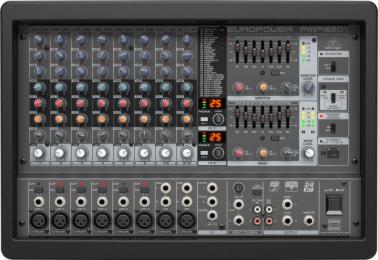
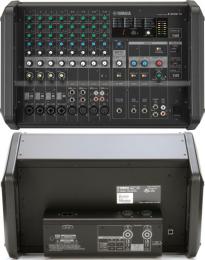
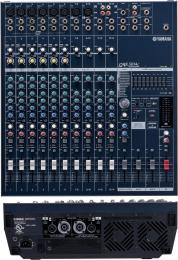
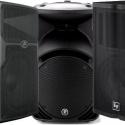
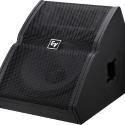
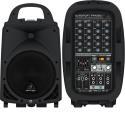
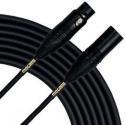
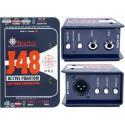
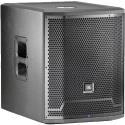
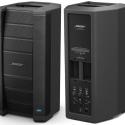
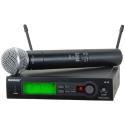
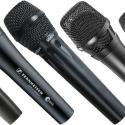
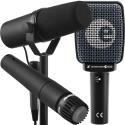

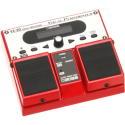
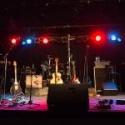
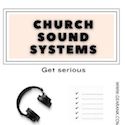





Comments
The following mixers came off
Submitted by Jason Horton on
The following mixers came off the recommended list when we published the 2022.10 Edition:
Publication of our December
Submitted by Jason Horton on
Publication of our December 2021 Edition resulted in the following mixers coming off the recommended list above, but you can still see our analysis of them:
We have removed the Yamaha
Submitted by Jason Horton on
We have removed the Yamaha EMX5016CF because it has been discontinued by Yamaha.
Our December 2020 update
Submitted by Jason Horton on
Our December 2020 update resulted in the following mixers coming off the recommended list above, but you can still see our analysis of them:
The following mixer has been
Submitted by Jason Horton on
The following mixer has been removed from our recommended list above due to a lack of availability: Peavey XR 1220 Powered Audio Mixer.
hello what power amp do I
Submitted by michael hollandwhat (not verified) on
Hello what power amp do I need to power my z10 thanks mick.
Hi Mick - I'm not sure what
Submitted by Jason Horton on
Hi Mick - I'm not sure what you mean by "z10", can you provide a link to an example?
I read it some where that we
Submitted by Vinh Mai (not verified) on
I read it some where that we should not use the power mixer to set up with power speaker due to conflict some thing between them and make the power speaker easy blow up after while use them. Is that true? if not then what is best mix between power speaker and mixer?
Powered means that they have
Submitted by Jason Horton on
Powered means that they have an amplifier built-in, so if you send an amplified signal from a powered mixer to a powered speaker which is expecting only a line level signal, then yes you will damage the powered speaker.
Technically, you could use a line level output from a powered mixer to safely drive a powered speaker, but then you wouldn't be using the amplifier in the mixer so you'd be paying for an amp you're not using and you'd have extra weight to lug around.
For these reasons it's best to use powered mixers with passive speakers (unpowered) and use unpowered mixers with powered speakers.
If i pick unpower mixer and
Submitted by Vinh Mai (not verified) on
If i pick unpower mixer and power speaker and sub speaker, which kind of sub speaker should go with that set? Do i need amplyfier with power sub speaker? Thank you for all your help in past post .
If you go with an unpowered
Submitted by Jason Horton on
If you go with an unpowered mixer then you need both powered subs and powered tops.
Ad a result of the January
Submitted by Jason Horton on
Ad a result of the January 2018 update of this guide the following mixers were removed from the recommended list above:
I have interests in the
Submitted by Nando (not verified) on
I have interests in the PreSonus StudioLive 16.0.2 USB. What where the reasons to remove this one? It's a digital mixer, seems really good for small home studio. Is it outdated? Please let me know, thank you.
The PreSonus StudioLive 16.0
Submitted by Jason Horton on
The PreSonus StudioLive 16.0.2 only just missed the cutoff for being included when we updated the guide due to other options having higher ratings.
It's ratings are still quite good and many people are happy with having chosen it.
mackie profx16v2 or Yamaha
Submitted by lulu (not verified) on
mackie profx16v2 or Yamaha MG16XU
help, please
totally newbie
Yamaha will be your best
Submitted by Jack (not verified) on
Yamaha will be your best choice for any high end application in professional audio equipment .
Where's The Soundcrafts
Submitted by JB (not verified) on
Where's The Soundcrafts?
Back when we completed the
Submitted by Jason Horton on
Back when we completed the research for this guide, Soundcraft mixers didn't make it onto our short-list, however a quick look at the current data suggests they will at least be on that list when we next update this guide.